RC Jets
- Filling Your Need for Speed
If you're looking to fly faster model aircraft, rc jets can give you the ultimate thrill and adrenaline rush!
Electric powered ducted fan (EDF) jets have become commonplace on our flying fields in recent years, and they offer an excellent gateway to the more serious gas turbine powered model jets.
But true rc turbine jets, however, are not for beginners. They are very serious model aircraft that you have to work up to after gaining a large amount of radio control flying experience, and an equally large amount of cash. They are very serious business and represent, arguably, the pinnacle of radio control model flying.
The great news is that EDF jets are much more affordable and many are stunningly realistic, making them an excellent choice for those of us who aren't in a position to own a turbine model.
Electric Ducted Fan (EDF) RC Jets
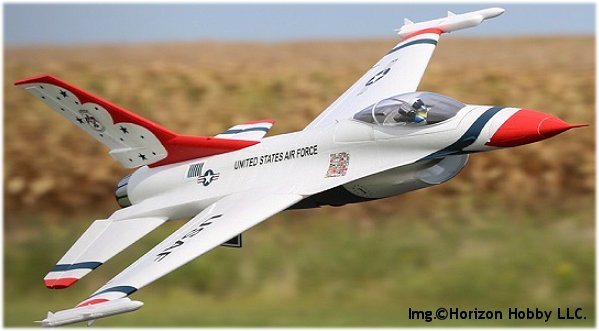
The E-flite® F-16 EDF jet shown above is a nice example of electric powered jets widely available today.
Indeed, E-flite is a world leading brand (from Horizon Hobby®) when it comes to EDF powered rc jets. There is a good range of high quality jets, and I can certainly recommend E-flite aircraft, having owned a few over the years.
An EDF jet is the best introduction to flying true radio control jets (i.e. with no propeller). They use an electric ducted fan unit as pictured below.
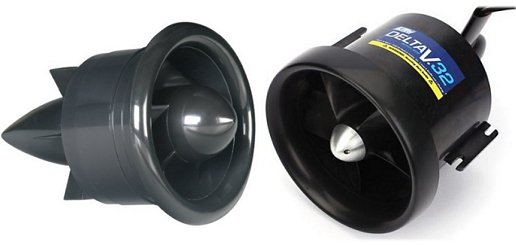
Above: A couple of typical EDF units for jets.
The ducted fan is a unit that comprises an electric motor coupled to a multi-bladed impeller. The motor spins the impeller at very high RPM (revs/minute). As it spins, the impeller draws air in through one or more forward-facing air intakes in the fuselage of the jet, and then forces the air down a cylindrical thrust tube and out the back of the jet. A lot of thrust can be generated by an EDF, although this is obviously going to vary from unit to unit.
EDF units are generally powered by high Kv brushless motors and need a higher capacity/high discharge rate lithium polymer battery pack because of the high current that they draw.
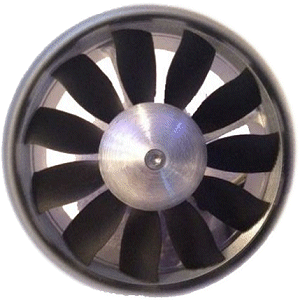 As technology has improved, impellers have increased in their blade count.
As technology has improved, impellers have increased in their blade count.
Whereas 5 or 6-bladed ones were commonplace, now 10, 11 and 12-bladed impellers are becoming the norm.
This increase in blade count not only produces more thrust for less RPM, but also creates a sound much more akin to a gas turbine, rather than the somewhat annoying whine of a lower blade count EDF.
Ready To Fly foam EDF rc jets have really taken hold in recent times and the number of good quality RTF EDFs available has increased dramatically, to the point where it's as common to see such a jet on the flying field as it is a plane or helicopter - that wasn't the case a few years ago when rc jets were very specialised models.
Some manufacturers have gone all-out to produce striking models with fantastic scale detail, such as this stunning Freewing Hornet F-18 shown below:
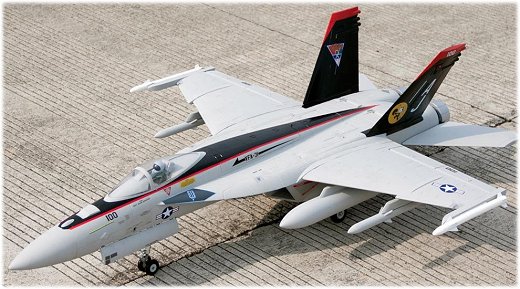
Foamie EDF jets like this aren't cheap and you do need to be an intermediate or experienced pilot to fly one safely.
In other words they're absolutely not for the beginner rc pilot*. But definitely something to work towards!
*I say not for the beginner pilot, and I do stand by that statement, but Horizon do market certain models towards the newbie pilot.
Their Habu STS, for example, comes loaded with beginner-friendly electronic stabilisation aids, as so many of their aircraft now do.
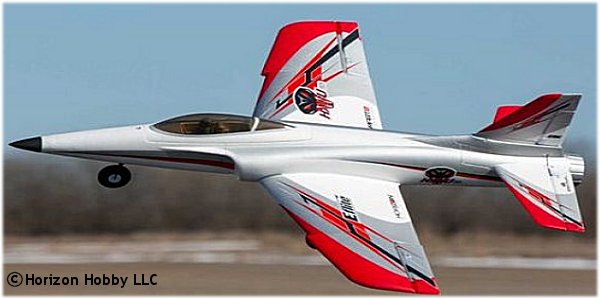
Above: E-flite's Habu STS does put rc jets into the beginner category.
Personally I'm a firm believer in traditional beginner planes when learning to fly radio control, but heck, if I was learning again from scratch I'd certainly be tempted by something like the Habu!
With all its electrical wizadry, I guess it can comfortably be classed as a 'trainer jet', and it even comes with a computer dongle and rc simulator download options.
It's great testament to the hobby that EDF jets have now become so widely available and relatively affordable, in exactly the same way that electric rc helicopters have.
Micro RC Jets
Like all other aircraft types in the radio control flying hobby, rc jets have become available in smaller scales.
Again, Horizon Hobby's E-flite brand pretty much leads the way here with the UMX range. The latest jets feature Horizon's AS3X™ stabilisation technology which helps fight wind gusts and the natural twitchiness of small model aircraft.
These micro-sized rc jets are excellent fun around the park, and are quite cheap to buy. You don't really need the same level of flying experience as for a larger jet, but their relatively fast speed does mean you need to have built up the necessary reactions and co-ordination before attempting to fly one.
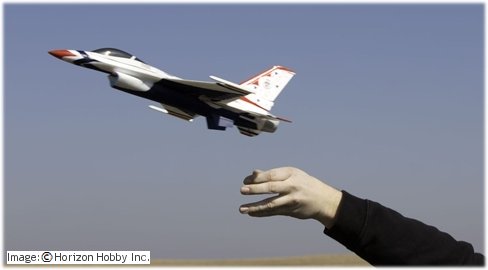
Above: UMX jets make a great-fun 'keep in the car' aircraft!
Gas Turbine RC Jets - the Real Deal
To many fliers an rc jet powered by a true model jet engine represents the pinnacle of radio control flying but, as mentioned earlier, such an rc jet is definitely best left alone until you have:
1] lots of confidence...
2] endless hours of rc flying experience and...
3] lots of money!!
When you've well and truly checked those 3 boxes, then maybe you can join this guy...
Holy cr*p! ![]() . He's been flying for more than a few weekends. And he's got waaay more confidence in his bank balance than I'll ever have in mine!
. He's been flying for more than a few weekends. And he's got waaay more confidence in his bank balance than I'll ever have in mine!
RC gas turbine jets are the ultimate in radio control flying.
Large scale jets look and sound amazingly realistic in the air and a properly built and well flown scale model is very impressive to watch in action.
If you ever get a chance to see some of these on display, then do. RC events that feature such aircraft are becoming more and more common, and it's worth trying to locate one if you can.
Top UK radio control pilot Ali Machinchy, now living in the USA and working for Horizon Hobby (a big loss to the UK rc scene!), always puts on an amazing display and flies large scale jets - indeed, he's one of the world's top show pilots.
If you ever get a chance to watch him, please do! If you don't, then at least enjoy this video of him flying a large scale (1/5) English Electric Lightning at one of the UK's top shows...
Model RC Jets on a Simulator
If you're more like me than Ali, then there is a cheaper option for trying your hand at flying proper gas turbine powered rc jets...
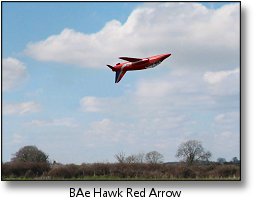 A good quality rc flight simulator can give you a realistic jet-flying experience, without breaking the bank. I have the Phoenix flight sim which features several turbine jets. A screenshot of the BAE Hawk is shown to the right.
A good quality rc flight simulator can give you a realistic jet-flying experience, without breaking the bank. I have the Phoenix flight sim which features several turbine jets. A screenshot of the BAE Hawk is shown to the right.
You can learn more about rc flight simulators here.
RC Jet Pros & Cons
One advantage rc jets have - whether virtual or real - is that they are not so adversely affected by wind like many rc airplanes are, due to the higher airspeeds and sleeker aerodynamics. This is a big plus when you're flying, although obviously every model has its own limitations and flight characteristics. Obviously modern stabilisation aids also help, where used.
A downside to jet flying is that because of their speed they need extra airspace; a faster flying model requires much more space for turns and aerobatic maneuvers than a slower flying aircraft, and you need to remember this when flying jets of any size.
This consequently brings in the problem of your jet being flown at a distance where it's not always easy to see exactly what it's doing; that in turn brings the serious risk of disorientation - a proven killer of rc aircraft of all types!
But flying any type of rc jet is always an adrenalin-filled experience and with radio control and electronic technology forever improving and reducing in cost, more and more rc jets will become available still, even for the lesser-experienced amongst us.
Having owned EDFs in the past and present, I can personally recommend the thrill of rc jet flying!
